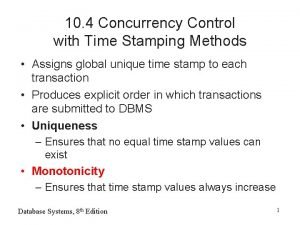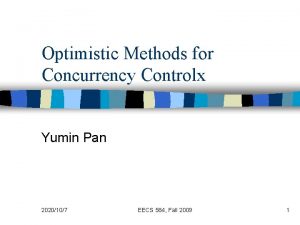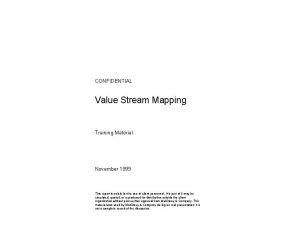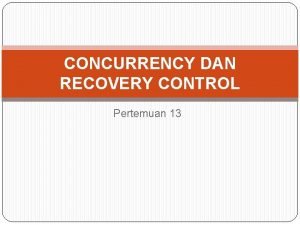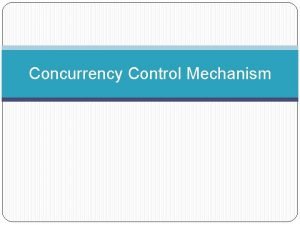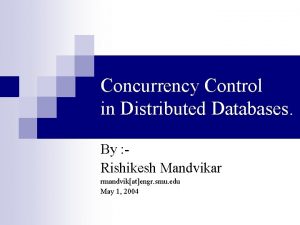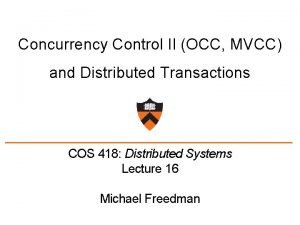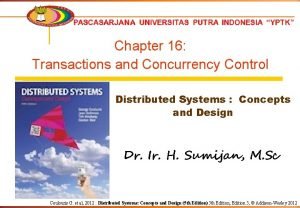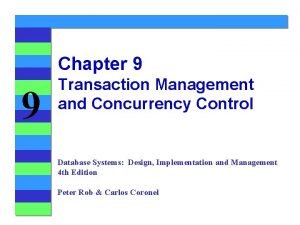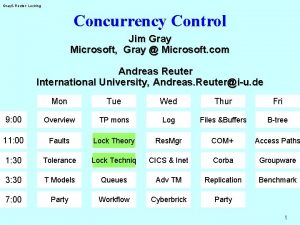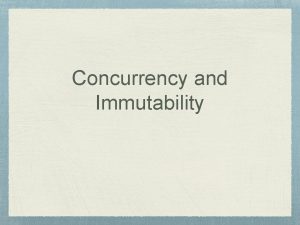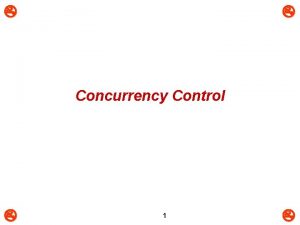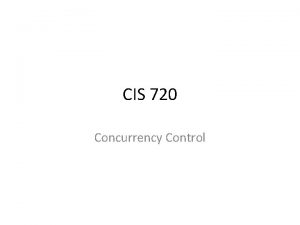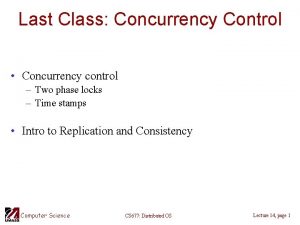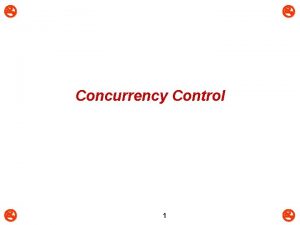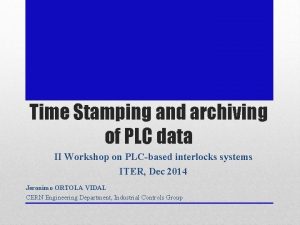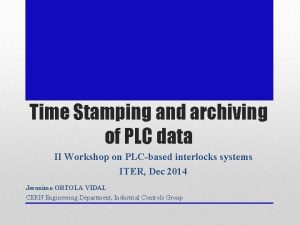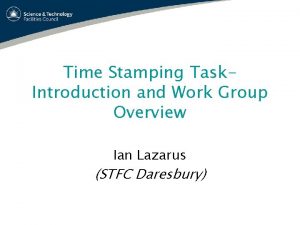10 4 Concurrency Control with Time Stamping Methods














- Slides: 14

10. 4 Concurrency Control with Time Stamping Methods • Assigns global unique time stamp to each transaction • Produces explicit order in which transactions are submitted to DBMS • Uniqueness – Ensures that no equal time stamp values can exist • Monotonicity – Ensures that time stamp values always increase Database Systems, 8 th Edition 1

Wait/Die and Wound/Wait Schemes • Wait/die – Older requesting transaction waits and – Younger requesting transaction is rolled back and rescheduled • Wound/wait – Older requesting transaction preempts (rolls back) younger transaction and reschedules it – Younger requesting transaction waits Database Systems, 8 th Edition 2

Database Systems, 8 th Edition 3

10. 5 Concurrency Control with Optimistic Methods • Optimistic approach – Based on assumption that majority of database operations do not conflict – Does not require locking or time stamping techniques – Transaction is executed without restrictions until it is committed – Phases: read, validation, and write Database Systems, 8 th Edition 4

10. 6 Database Recovery Management • Restores database to previous consistent state • Based on atomic transaction property – All portions of transaction treated as single logical unit of work – All operations applied and completed to produce consistent database • If transaction operation cannot be completed – Transaction aborted – Changes to database rolled back (undone) Database Systems, 8 th Edition 5

Concepts that Affect Transaction Recovery • Write-ahead-log protocol: ensures transaction logs are written before data is updated • Redundant transaction logs: ensure physical disk failure will not impair ability to recover • Buffers: temporary storage areas in primary memory • Checkpoints: operations in which DBMS writes all its updated buffers to disk Database Systems, 8 th Edition 6

Transaction Recovery • Makes use of deferred-write and write-through techniques • Deferred-write technique – Transaction operations do not immediately update physical database – Only transaction log is updated – Database is physically updated only after transaction reaches its commit point using transaction log information Database Systems, 8 th Edition 7

Transaction Recovery • Recovery process for deferred-write : – Identify last checkpoint – If transaction committed before checkpoint • Do nothing – If transaction committed after checkpoint • Use transaction log to redo the transaction – If transaction had ROLLBACK operation or was left active • Do nothing because no updates were made Database Systems, 8 th Edition 8

Transaction Recovery • Write-through technique – Database is immediately updated by transaction operations during transaction’s execution • Recovery process for write-through – Identify last checkpoint – If transaction was committed before checkpoint • Do nothing – If transaction committed after last checkpoint • DBMS redoes the transaction using “after” values – If transaction had ROLLBACK or was left active • Uses the before value in the transaction log records to ROLLBACK (undo) Database Systems, 8 th Edition 9

Database Systems, 8 th Edition 10

Summary • Transaction: sequence of database operations that access database – Logical unit of work • No portion of transaction can exist by itself – Five main properties: atomicity, consistency, isolation, durability, and serializability • COMMIT saves changes to disk • ROLLBACK restores previous database state • SQL transactions are formed by several SQL statements or database requests Database Systems, 8 th Edition 11

Summary (continued) • Transaction log keeps track of all transactions that modify database • Concurrency control coordinates simultaneous execution of transactions • Scheduler establishes order in which concurrent transaction operations are executed • Lock guarantees unique access to a data item by transaction • Two types of locks: binary locks and shared/exclusive locks Database Systems, 8 th Edition 12

Summary (continued) • Serializability of schedules is guaranteed through the use of two-phase locking • Deadlock: when two or more transactions wait indefinitely for each other to release lock • Three deadlock control techniques: prevention, detection, and avoidance • Time stamping methods assign unique time stamp to each transaction – Schedules execution of conflicting transactions in time stamp order Database Systems, 8 th Edition 13

Summary (continued) • Optimistic methods assume the majority of database transactions do not conflict – Transactions are executed concurrently, using private copies of the data • Database recovery restores database from given state to previous consistent state Database Systems, 8 th Edition 14
 Time stamping in dbms
Time stamping in dbms On optimistic methods for concurrency control
On optimistic methods for concurrency control Clock drift
Clock drift Acme stamping value stream mapping
Acme stamping value stream mapping Maggie mcgeeney
Maggie mcgeeney Sinter gear factory
Sinter gear factory Concurrency control and recovery
Concurrency control and recovery Concurrency control and recovery
Concurrency control and recovery Pitfalls of lock based protocol
Pitfalls of lock based protocol Concurrency control in distributed databases
Concurrency control in distributed databases Timemasters locks
Timemasters locks Transactions and concurrency control in distributed systems
Transactions and concurrency control in distributed systems Recovery with concurrent transaction in dbms
Recovery with concurrent transaction in dbms Microsoft flow concurrency control
Microsoft flow concurrency control Timestamp based concurrency control
Timestamp based concurrency control
